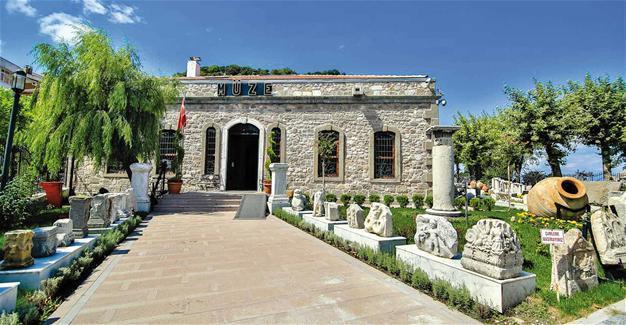Ancient civilizations on show at Amasra Museum
BARTIN – Anadolu Agency

The Amasra Museum, home to more than 3,000 archaeological and ethnographical artifacts from the Hellenistic, Roman, Byzantine, Genoese, Seljuk and Ottoman periods, reveals the northern province of Bartın’s 5,000-year-old history.
The Amasra district, where the museum is located, bears the name of Persian queen Amastris, who ruled the city after the Lydians.
The museum opened in 1969 at a primary school building after many artifacts were consecutively extracted from the region. The museum moved to its new place in 1982 after the building of a navy school was bought by the Culture and Tourism Ministry.
With four exhibition halls, the museum displays pieces extracted from graves such as tear glasses, golden and bronze jewelries, bronze statuettes, bracelets, hooks, crosses, weapons, candles, as well as copper kitchen tools, writing tools, chandeliers, seals, scales, ceramics, rings and traditional dresses.
As part of UNESCO’s cultural heritage works, the restoration work in the museum has neared an end and is set to reopen this year. The museum also hosts primary and secondary school and university students by organizing educational activities.
Historic atmosphere from early Bronze Age to Ottoman eraThe museum’s director, Baran Aydın, said Amasra currently had a population of 6,500 but believed there were more people in the ancient times.
The population in the ancient times was between 20,000 and 25,000, he said. “Therefore, there were many ancient settlements on the plain fields of the district. Many artifacts are brought to the museum although there is no archaeological works around. These artifacts were coincidentally found during constructions works,” he added.
Aydın said the museum had been under restoration for three years but it would open soon.
“It is possible to see artifacts from the early Bronze Age to the Ottoman times in the museum. This history can be seen uninterruptedly in the museum. We are very rich in artifacts,” he added.
Becoming a notable museumAydın said after the restoration works, the Amasra Museum would become one of the important museums in Turkey and Europe.
“The museum draws interest from local and foreign researchers and visitors. We have a sculpture collection in the museum; it is made up of pieces that were unearthed in the 1990s during excavations in an industrial zone. This draws interest especially from foreign academics. Researches on these have still been continuing. We have almost seven to eight sculptures found on this field.”
Aydın noted that in addition to the sculpture collection, the museum also exhibited glass pieces.
“The glass collections are important among international circles. They have traces of Bartın’s local culture and the Ottoman culture. These traces are objects of its ethnography and they can be seen in the museum. The jewelries used by women in the 19th century, bindallı dresses [bridal gowns] used at the time, and the findings from the latest times of the Ottoman state are among the most popular artifacts in the museum,” he said.
 The Amasra Museum, home to more than 3,000 archaeological and ethnographical artifacts from the Hellenistic, Roman, Byzantine, Genoese, Seljuk and Ottoman periods, reveals the northern province of Bartın’s 5,000-year-old history.
The Amasra Museum, home to more than 3,000 archaeological and ethnographical artifacts from the Hellenistic, Roman, Byzantine, Genoese, Seljuk and Ottoman periods, reveals the northern province of Bartın’s 5,000-year-old history.